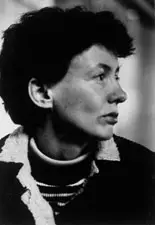 Judy Grahn is an American poet. She is openly lesbian and has written many lesbian feminist works. Judy Grahn (b. 1940) is a love poet too, although her poetry is not particularly erotic. The Work of a Common Woman is sensual, but celebrates sweat and hard work rather than sexual play. Grahn is a “working-class poet,” but she is neither a socialist-realist nor a slumming idealist. “Commonness” to her is not a new kind of exclusivity, for her “common woman” is Everywoman, that which is ordinary and common and binds women together. She is a love poet in the traditions of Whitman, Ginsberg, cummings, with more than a little bit of Gertrude Stein. Grahn borrows many of their repetitive, incantatory techniques, but transmutes them to celebrate the energy common to women in their diverse work.
Judy Grahn is an American poet. She is openly lesbian and has written many lesbian feminist works. Judy Grahn (b. 1940) is a love poet too, although her poetry is not particularly erotic. The Work of a Common Woman is sensual, but celebrates sweat and hard work rather than sexual play. Grahn is a “working-class poet,” but she is neither a socialist-realist nor a slumming idealist. “Commonness” to her is not a new kind of exclusivity, for her “common woman” is Everywoman, that which is ordinary and common and binds women together. She is a love poet in the traditions of Whitman, Ginsberg, cummings, with more than a little bit of Gertrude Stein. Grahn borrows many of their repetitive, incantatory techniques, but transmutes them to celebrate the energy common to women in their diverse work.
Her sensualness occurs in the dance-like, ritualistic patterns of much of her poetry. She seems able to find songs or enchantments in virtually every aspect of the language of women. “She Who,” a group of diverse pieces which Grahn has recorded as well as published, contains a birth chant made from the midwife’s instructions during natural childbirth, a funeral rite, an exorcism of all the hateful names that men have called women, a liturgy of heroic women evoked to give energy and to heal. These rituals, designed as Grahn writes, to make “our poetry what it should be and once was: specific, scientific, valuable, of real use,” are interspersed with fables and exempla, the whole sequence resembling a Book of Common Prayer for women. Holding it all together is the powerfully evocative, syntactically polypositional “She Who.” These poems are social activities, designed to replicate in readers, especially through reading aloud, the ideal of Lesbian civility.
Her most interesting and ambitious poem is the meditation, “A Woman is Talking to Death.” Grahn has always insisted in her poems on what is factual, plain and simple. There are no obvious metaphors or myths. She has said of her early sequence, “The Common Woman”: “I wanted to accentuate the strengths of their persons without being false about the facts of their lives.” Of “A Woman is Talking to Death” she wrote, “This poem is as factual as I could possibly make it.” The precise description of a fatal accident involving a motorcycle and an automobile on the Bay Bridge becomes an extended meditation on the futility of trying to work within a society fascinated by destruction. The poem clarifies sharply what women know of the difference between love and death; as Grahn says of it, it began “a redefinition for myself of the subject of love.”
Grahn idealizes but does not sentimentalize the Lesbian bond, because she makes us aware of the facts of aloneness, the penalties of her choice, and the tenuousness of her dream. She is also tough in rejecting the false securities and illusory paradises that romantic idealism produces. Grahn does not look to others to teach her love; her love comes with integrity. Love is a disciplined school of self-knowledge, self-evaluation, learned through the world of work and fact. It is that discipline which underlies the apocalyptic dream defined in “A Woman is Talking to Death” . . .
